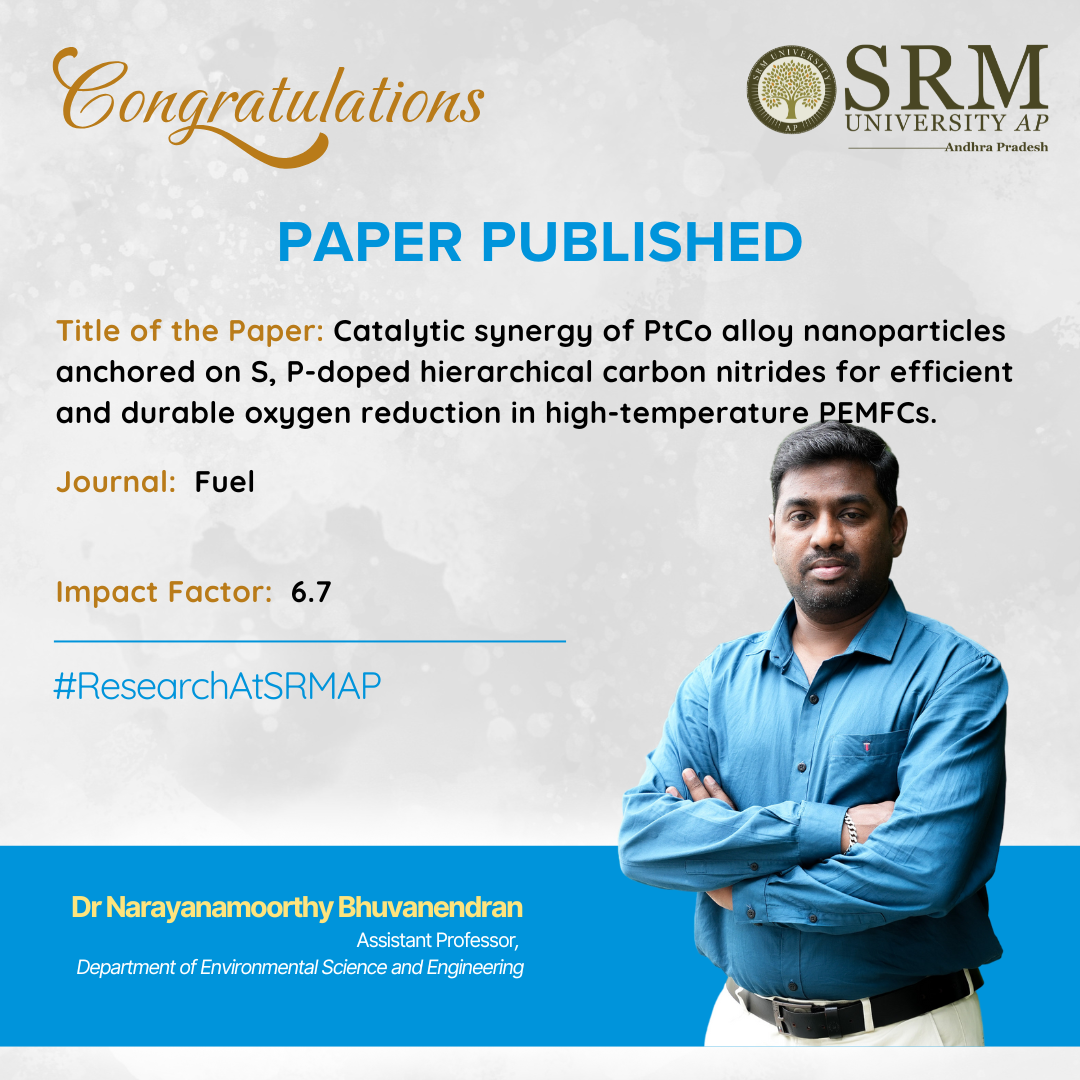 Assistant Professor, Dr Narayanamoorthy Bhuvanendran from the Department of Environmental Science and Engineering has published a research paper titled, Catalytic synergy of PtCo alloy nanoparticles anchored on S, P-doped hierarchical carbon nitrides for efficient and durable oxygen reduction in high-temperature PEMFCs. His research presents a new type of catalyst that could enhance the efficiency and longevity of fuel cells, making them more viable for sustainable energy applications.
Assistant Professor, Dr Narayanamoorthy Bhuvanendran from the Department of Environmental Science and Engineering has published a research paper titled, Catalytic synergy of PtCo alloy nanoparticles anchored on S, P-doped hierarchical carbon nitrides for efficient and durable oxygen reduction in high-temperature PEMFCs. His research presents a new type of catalyst that could enhance the efficiency and longevity of fuel cells, making them more viable for sustainable energy applications.
Abstract:
Intensified electrochemical corrosion under high-temperature and phosphoric acid conditions poses a significant challenge to the catalysts in high-temperature proton exchange membrane fuel cells (HT-PEMFCs). Herein, a S, P-doped hierarchical porous carbon nitride (S, P-HCN) supported PtCo alloy catalyst was developed to address this issue. The multilayered porous structure of S, P-HCN ensures high metal dispersion, a large specific surface area, and enhanced mass transfer. The PtCo/S, P-HCN catalyst exhibits remarkable performance, with specific activity (1.27 mA cmPt-2 at 0.80 V), mass activity (0.51 mA µgPt-1 at 0.80 V), and electrochemical active surface area (ECSA) (39.9 m2 g-1Pt), surpassing commercial 20 % Pt/C by 2–3 times. Durability tests over 5000 potential cycles reveal excellent retention of mass activity (84 %) and specific activity (83.2 %) at 0.80 V, with only a minor 14 mV shift in half-wave potential. This enhancement stems from the synergistic effects between PtCo alloy nanoparticles and S, P-HCN, which modulate Pt- electronic structure, strengthen metal-support interactions, and boost catalytic efficiency. Single-cell HT-PEMFC studies demonstrate a peak power density of 377.4 mW cm−2 for PtCo/S, P-HCN, comparable to commercial Pt/C (398 mW cm−2), with reduced voltage degradation at low current densities. This work presents a promising approach for improving cathode materials and advancing HT-PEMFC performance.
Explanation in Research in Layperson’s Terms:
The growing demand for green energy has increased the interest in clean, sustainable, and efficient fuel for electricity generation. Hence, hydrogen is one of the promising choices as green energy source, which can be used as a fuel in fuel cell technology. Among various types of fuel cells, proton exchange membrane fuel cells (PEMFCs) are the fastest-growing energy technologies, especially in automotive applications, owing to their high-power density and rapid start-up and shutdown capabilities compared to other fuel cell types. PEMFCs are classified by operating temperature into low-temperature (LT-PEMFC) and high-temperature (HT-PEMFC). While LT-PEMFCs (operating at ∼ 80 °C) have advanced significantly, they face challenges such as complex heat and water management and the high cost of producing the required high-purity hydrogen fuel. HT-PEMFCs, operating at 150–200 °C, overcome low-temperature PEMFC limitations with fuel flexibility, simpler design, improved water management, and greater efficiency, while enhancing oxygen reduction reaction (ORR) kinetics and diffusion processes. Till to date, Pt/C is the most used catalyst in PEMFCs due to its high activity and stability. However, in HT-PEMFCs, phosphate species from the phosphoric acid electrolyte strongly adsorb onto Pt surfaces, blocking active sites for O2 adsorption and reducing overall cathode performance. To address this bottleneck issues, a novel hybrid support materials with 3D hierarchical porous morphology, high surface area, porosity, and more accessible active sites has been developed which provides distinct benefits over conventional carbon materials for enhancing ORR performance. Their extensive surface area and interconnected pores facilitate better active site distribution and efficient mass transfer during the ORR process and leads to extended fuel cell performance.
Practical Implementation and Social Implications:
In this work, we have design and developed the PtCo/S,P-HCN catalyst, through a simple hydrothermal process, constructs a synergistic combination of structural and compositional features that significantly enhance the cathodic ORR performance. The 3D porous architecture with uniformly distributed PtCo nanoparticles and S, P-doped carbon nitride matrix ensures improved Pt utilization, active site accessibility, and effective charge transport. Nitrogen doping (graphitic-N and pyridinic-N) facilitates efficient electron transfer, while heteroatom doping (S and P) optimizes *OOH binding energy, promoting oxygen adsorption and O–O bond cleavage. The interatomic alloy structure of PtCo modulates the Pt d-band center, further boosting ORR kinetics. These combined effects result in superior catalytic activity (SA: 1.268 mA cmPt-2, MA: 0.506 mA µgPt-1, ECSA: 39.9 m2 g-1Pt) and durability, retaining 84 % MA and 83.2 % SA after 5000 cycles with minimal half-wave potential loss (14 mV). In HT-PEMFC tests, it achieved a peak power density of 377.4 mW cm−2, matching commercial Pt/C (398 mW cm−2), while demonstrating greater PA resistance and stability. These findings highlight the synergistic effects of the PtCo/S,P-HCN catalyst and its potential as a robust ORR electrocatalyst for HT-PEMFC applications.
Collaborations:
Prof. Huaneng Su, Jiangsu University, China.
Future Research Plans:
Based on the observations from the above research, we plan to further explore modifications to the electronic properties of the catalyst to enhance the surface adsorption of reaction intermediates, thereby improving its electrocatalytic performance for various key electrochemical reactions.

